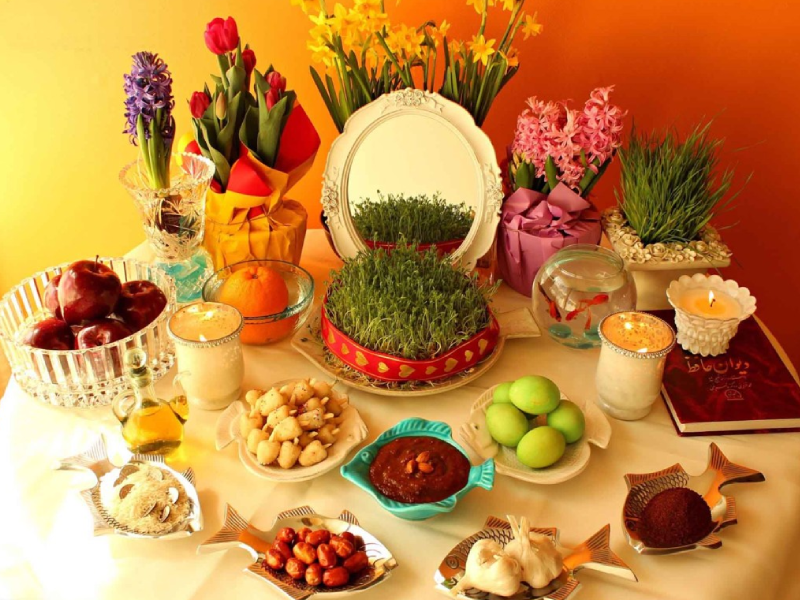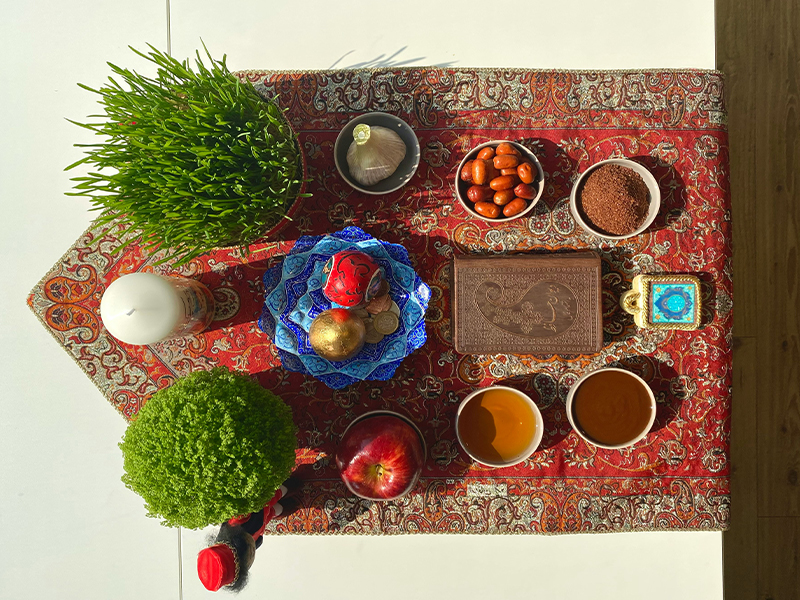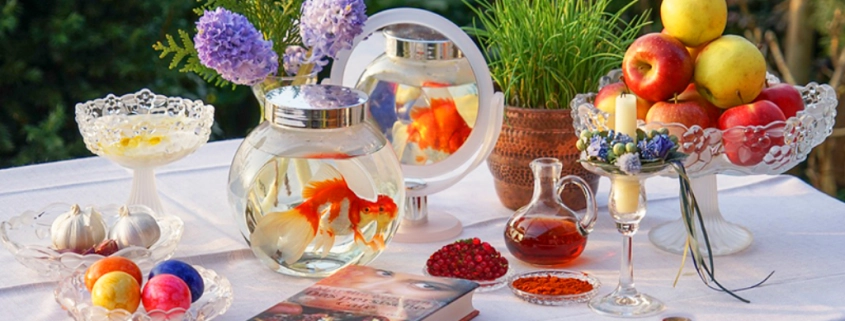Nowruz Haft Sin Table (Meaning, History, Items)
Persian New Year, known as Nowruz, is a lively celebration that happens when spring arrives and nature begins afresh. One of the most loved parts of this celebration is the Haft Sin Table. It’s a special display that shows the feeling of Nowruz. This article talks about why the Haft Sin Table is important in Persian culture and how it welcomes the new year, inviting prosperity and renewal into homes and hearts.
What Is Haft Sin Meaning?
“Haft Sin” translates to “Seven S’s” in English. It refers to a traditional Persian custom where a table is set with seven symbolic items, each starting with the Persian letter “sin” (س).
These items typically represent blessings, renewal, and good fortune, and they are arranged on the table in preparation for Nowruz, the Persian New Year celebration. The Haft Sin table, called Sofreh Haft Sin, is a central part of the Nowruz festivities, symbolizing the hopes and aspirations for the coming year.
Haft Sin Table Items
The Haft Sin Table is a big part of celebrating Nowruz, the Persian New Year. It’s full of symbols that foster good things for the year ahead. Each item on the table starts with the Persian letter “sin” (س) and stands for different blessings and wishes.
Sabzeh
Sabzeh is an important part of the Haft Sin Table during Nowruz. It’s usually sprouted wheat, barley, or lentils. Sabzeh represents new beginnings and growth, like when plants start to grow in spring. It shows that even when things seem tough, there’s always a chance for a fresh start.
Having Sabzeh on the table also reminds us of how connected we are to nature and the earth. It’s a way to celebrate the beauty of life and the cycles of growth that happen every year.
People often start growing Sabzeh a few weeks before Nowruz. They take care of the seeds until they sprout and grow enough to be put on the Haft Sin Table. Seeing the green Sabzeh on the table makes the celebration feel more lively and joyful.

Samanu
Samanu is a special sweet pudding made from wheat that has started to sprout. It’s a traditional treat often found on the Haft Sin Table during Nowruz celebrations. Samanu is more than just a delicious dessert. It’s a symbol of abundance and fertility.
In Persian culture, Samanu is believed to bring good luck and prosperity. It represents the hope for plenty of good things in the coming year, like having lots of money, food, and happiness.
Sib
Sib, which means apple, is all about being healthy and looking good. It’s like a wish for everyone to stay strong and healthy in the new year.
Senjed
Senjed, which is dried fruit from a special tree (oleaster), is about love and being close to family and friends.
Serkeh
Serkeh, or vinegar, reminds us to be patient and wise when life gets tough. It’s a symbol of being strong and staying hopeful even when things are hard.
Sir
Sir means garlic, which is thought to keep bad luck away and protect us from harm.
Somāq
Somāq, or sumac, is like the sunrise, showing that good things are coming and darkness will go away. It’s a sign of hope and looking forward to better times.
Sekkeh
Sekkeh, which means coins, stands for having lots of money and being wealthy in the new year.
All these symbols together make the Haft Sin Table a special and meaningful part of Nowruz celebrations. They bring hope and good wishes for the year ahead.
Apart from what each symbol means, the items on the Haft Sin Table bring families closer together. They work together to set up the Haft Sin Table, strengthening their relationships and the things they believe in.
Gathering around the table shows that they’re united and support each other, which is really important during this happy time of year.
Haft Sin History
The Haft Sin tradition has been around for a really long time, going back to ancient Persia when Zoroastrianism was the main religion. It’s hard to say where it started, but historians think it might have been part of the Nowruz celebrations, which are all about nature coming back to life and light beating the darkness.

In the beginning, the Haft Sin Table probably had items that meant important things in Zoroastrian beliefs. For example, plants that symbolize growth and fertility, candles, pastries, wine, and things representing purity and having lots of pleasing stuff.
As time went on, the tradition changed a bit, adding new symbols and fitting in accordance with the culture and religion at the moment.
Even though Persia has seen a lot of changes over the years, like different rulers and new religions, the Haft Sin tradition stayed strong. It’s a way for Iranians to hold onto their culture and pass it down to the next generations, no matter what is going on around them.
Nowadays, the Haft Sin tradition is still a big part of Iranian culture. Both in Iran and in other countries where Iranians live.
While some things stay the same, like having sprouted wheat and sweet pudding on the table, families often make their own versions, adding things that mean something special to them or that fit with modern life.
Nowruz Haft Sin Set
In Iran, people celebrate the Haft Sin tradition in different ways, depending on where they live. In the north, provinces like Gilan and Mazandaran, which have lots of rice fields and forests, the locals use local foods like rice, citrus fruits, and herbs on their Haft Sin Tables. This shows how much they value their land and farming traditions.
But in the central desert areas where water is scarce and it’s hard to grow crops, they might use things like nuts, dried fruits, and seeds instead. These items represent their ability to overcome challenges and find creative ways to survive in tough conditions.
In big cities like Tehran and Isfahan, where there’s a mix of cultures and ideas, Haft Sin Tables might have a more modern twist. Families might use trendy items alongside traditional ones, like fancy fruits and spices from other countries. This shows how diverse and innovative these cities are.

Outside of Iran, Persian communities celebrate Nowruz in their own way. In countries like the United States, Canada, and Germany, they mix Persian traditions with local customs. For example, Iranian-Americans might include American symbols like flags alongside the traditional Haft Sin items, showing pride in their heritage and their new home.
Similarly, Iranian-Canadians might add maple syrup or local fruits to their Haft Sin Tables, connecting to their new country’s culture and landscape.
Conclusion
In wrapping up, looking at how people set Haft Sin in different places shows us the beauty of Persian culture and how it’s shared around the world. Whether it’s in the green fields of Gilan or the busy streets of Tehran, each region has its own way of celebrating with special symbols that reflect their land and traditions.
Even outside Iran, Persian communities add their own twist to Haft Sin, mixing it with local customs to make unique celebrations. From big cities to small towns, Iranians everywhere come together to celebrate their culture, connect with each other, and welcome the new year with hope.
By seeing how Haft Sin brings people together, we’re reminded of how cultural traditions can bring joy and unity to our lives. It’s a reminder of the strength of Persian culture and the values of starting anew, abundance, and being together.
Are you planning to travel to Iran and looking for an Iran resort? Consider Matinabad Eco-resort.





Leave a Reply
Want to join the discussion?Feel free to contribute!